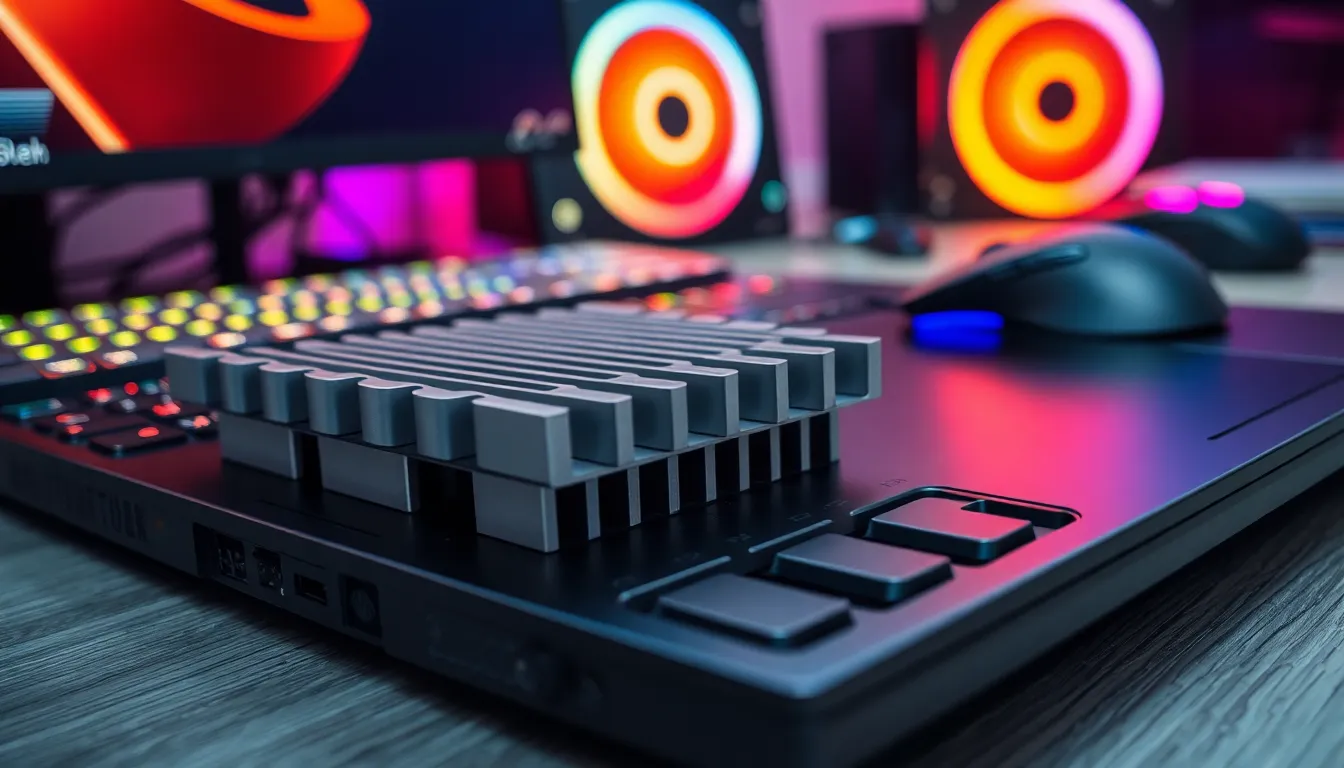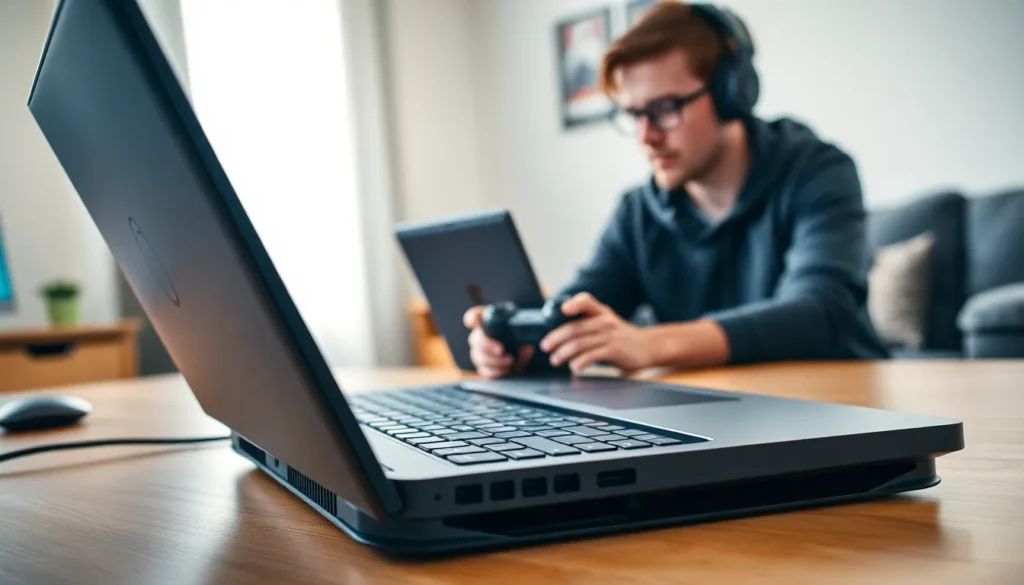Table of Contents
ToggleIn a world where laptops are more essential than ever, overheating can feel like the ultimate betrayal. Imagine you’re on a roll, typing away, and suddenly your trusty notebook turns into a hot plate. Notebook cooling technology is here to save the day, ensuring that laptops stay as cool as a cucumber—even when multitasking like a pro.
Gone are the days of fans that sound like a jet engine taking off. Today’s cooling solutions are sleek, efficient, and whisper-quiet, keeping both your device and your sanity intact. Whether you’re gaming, streaming, or just trying to finish that work presentation, understanding the latest in cooling tech can help keep your laptop running smoothly and your frustration at bay. Let’s dive into the cool world of notebook cooling technology and discover how it can elevate your computing experience.
Overview of Notebook Cooling Technology
Cooling technology plays a vital role in maintaining the performance and longevity of notebooks. Efficient cooling prevents hardware from overheating, which can cause reduced performance and system damage.
Importance of Cooling in Notebooks
Cooling remains essential in notebooks to ensure uninterrupted productivity. Overheating can lead to thermal throttling, which impacts speed and responsiveness during high-demand tasks like gaming or video editing. Proper cooling enhances device reliability, prolongs battery life, and promotes user comfort. Effective cooling solutions can significantly reduce noise levels, improving the overall user experience.
Types of Cooling Technologies
Several cooling technologies exist to manage heat in notebooks. Active cooling relies on fans that draw heat away from components, providing direct airflow that enhances efficiency. Passive cooling employs heat sinks and thermal pads to dissipate heat without mechanical components. Liquid cooling offers advanced solutions by using cooling liquid to transfer heat away from crucial parts. Additionally, hybrid systems combine air and liquid methods for maximum heat management. Each type of cooling technology contributes uniquely to laptop performance and user satisfaction.
Passive Cooling Solutions

Passive cooling solutions play a crucial role in maintaining notebook temperatures without relying on active components like fans. They allow for consistent device performance across various tasks, including gaming and video editing.
Heat Sinks
Heat sinks conduct heat away from vital components, ensuring efficient thermal regulation. Made from materials like aluminum or copper, they provide substantial surface area for heat dissipation. Adequate contact with processors ensures that excess heat moves away quickly. Many notebooks incorporate heat sinks as integral parts of their thermal management systems. This positioned method effectively enhances laptop reliability and aids in prolonging life due to reduced overheating.
Thermal Pads
Thermal pads facilitate better heat transfer between components and heat sinks. Specific thermal conductivity ratings indicate their efficiency in conducting heat. These pads compress easily, ensuring a snug fit between surfaces, which optimizes heat dissipation. Various thicknesses cater to different thermal needs, making them versatile solutions. Incorporating these pads helps maintain stable operating temperatures, particularly during intense computing tasks. Overall, they significantly contribute to reducing the risk of thermal throttling.
Active Cooling Solutions
Active cooling solutions are vital for maintaining optimal laptop performance. These technologies actively manage heat produced during intensive tasks, ensuring devices run efficiently.
Fans and Ventilation
Fans play a crucial role in notebook cooling. They draw in cooler air from the environment while expelling hot air generated by internal components. Laptops often come equipped with multiple fans to maximize airflow. Efficient ventilation designs optimize fan placement, promoting effective heat dissipation. Noise levels vary by design, with modern fans operating quietly while maintaining performance. Fan speed adjustments occur dynamically based on temperature, enhancing cooling only when needed.
Liquid Cooling Systems
Liquid cooling systems provide advanced thermal management for notebooks. These systems utilize liquid coolant to absorb heat from critical components like CPUs and GPUs. Heat exchange occurs via radiators, where fans assist in dissipating heat. Liquid cooling systems excel in maintaining lower temperatures under heavy loads, significantly improving performance. They can also enhance overall system efficiency by reducing thermal throttling risks. While typically found in high-performance laptops, they’re gaining popularity among mainstream models for their effectiveness.
Emerging Trends in Notebook Cooling Technology
Notebook cooling technology continues to evolve, focusing on efficiency and performance. Emerging innovations now contribute significantly to thermal management.
Innovative Materials
Advanced materials play a crucial role in enhancing notebook cooling. Graphene, for instance, offers excellent thermal conductivity, enabling efficient heat dissipation. Copper remains a popular choice due to its high thermal performance, making it effective in heat sinks. Manufacturers also explore phase-change materials that absorb and release heat effectively, stabilizing temperatures. These innovative materials contribute to lighter designs while maintaining high cooling efficiency. Additionally, using carbon fiber in components helps reduce weight and improve overall thermal regulation.
Advanced Algorithms for Temperature Management
Temperature management has transformed with advanced algorithms designed for real-time cooling adjustments. These algorithms analyze component temperatures and dynamically adjust cooling output. Machine learning enables systems to adapt based on usage patterns, optimizing performance while minimizing noise levels. By predicting heat spikes during intensive processes, these algorithms adjust fan speeds proactively. Furthermore, integration with power management allows devices to balance performance and thermal output effectively. Such advancements ensure notebooks operate within optimal thermal limits, improving user experience during demanding activities.
Challenges and Considerations
Notebook cooling technology faces key challenges that affect both performance and user satisfaction. Noise levels in active cooling systems often impact the user experience, especially during quiet activities like reading or video editing. Traditionally, fans create background noise while cooling, which can disrupt focus. Modern fans, however, aim for quieter operation through innovative designs and adaptive speed controls.
Energy efficiency is another critical consideration. Effective cooling solutions must manage heat without excessive power consumption. Active cooling can consume more energy, which reduces battery life. Passive cooling systems present a more energy-efficient option, maintaining temperatures without active components, thereby extending battery longevity. Strategic design improvements also enhance energy management, making laptops more environmentally friendly.
Notebook cooling technology is essential for maintaining optimal performance and user satisfaction. As laptops become more powerful and compact, effective cooling solutions are crucial in preventing overheating during demanding tasks. From innovative passive systems to advanced liquid cooling, each method plays a significant role in enhancing thermal regulation.
Emerging materials and smart algorithms are paving the way for more efficient and quieter cooling options. These advancements not only improve performance but also contribute to longer battery life and a more comfortable user experience. As technology continues to evolve, staying informed about cooling solutions will help users make better choices for their laptops, ensuring reliability and efficiency in every task.




